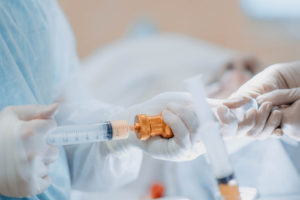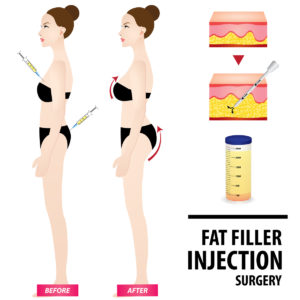Fat Transfer to Breasts! The Next Big Thing in Augmentation
Many women want to enhance their breasts but are hesitant to undergo typical breast augmentation with implants  because of the maintenance and risks associated. Enter fat transfer to the breast. A fat transfer to the breasts, sometimes called a natural breast augmentation, or a fat transfer breast augmentation, is a two-part process that takes excess, unwanted fat from one part of the body through liposuction and injects it into the breast to enhance their size and shape. The results can be more natural in look and feel than implants and it leaves no scarring on the breast. Plus, there’s also the sculpting benefits that come with liposuction. It’s often chosen by women who want to enhance their breasts but are hesitant to undergo typical breast augmentation with implants because of the maintenance and risks associated.
because of the maintenance and risks associated. Enter fat transfer to the breast. A fat transfer to the breasts, sometimes called a natural breast augmentation, or a fat transfer breast augmentation, is a two-part process that takes excess, unwanted fat from one part of the body through liposuction and injects it into the breast to enhance their size and shape. The results can be more natural in look and feel than implants and it leaves no scarring on the breast. Plus, there’s also the sculpting benefits that come with liposuction. It’s often chosen by women who want to enhance their breasts but are hesitant to undergo typical breast augmentation with implants because of the maintenance and risks associated.
While overwhelmingly an extremely safe procedure, there are minimal risks involved. The biggest risks and complications happen in the liposuction part of the procedure, with the biggest risk being contour irregularity. That is, dimpling or rivets in the skin from not performing the liposuction properly. Dr. Barrett uses a safe liposuction technique that involves breaking up the fat very carefully before removing it, using small cannulas, and what may seem obvious, but unfortunately isn’t always the case with some surgeons: taking his time during the procedure. Additional risks include:
- Infection, both with the liposuction procedure itself and when you’re transferring the fat, as there’s no blood supply in removed fat;
- Scarring is of course a risk with any surgical operation;
- A hematoma is also a known risk for blood collection after liposuction or the fat transfer;
- Nipple sensitivity is always a risk during any kind of surgery around the areola;
- Loss of breast feeding ability is also a risk, though it’s important to note there’s no evidence that shows the loss of breast feeding ability.
In other words, any time you do surgery on the breast it can potentially affect its functionality. Additionally, if not performed properly, fat transfers can result in oil cysts, where the fat accumulates and needs to be drained. Finally, while not a health risk, there’s also the chance of disappointment in expected results. Typically this is due to the fat not all “taking”, resulting in a breast size smaller than desired.
Every surgery carries inherent risks; many of those mentioned above can be mitigated by choosing a board-certified plastic surgeon with experience in performing fat transfer to the breast. Additionally, a patient’s personal health also plays a big part in not only mitigating many surgical risks, but also in the duration and severity of recovery.
 As with any surgical procedure, there is of course recovery time. However the recovery from fat transfer to breasts is markedly less than with traditional breast augmentation with implants. Each patient and procedure is different, so each recovery will be different. Generally speaking, liposuction recovery for the patient is actually going to be more significant than the fat transfer recovery. Patients should give themselves about two weeks to recover: three days of solid downtime and relative downtime for the remainder of the two weeks. Some patients feel comfortable returning to work after five days, while others take longer, depending on the amount of liposuction. There may be some minor discomfort, swelling and bruising immediately after natural breast augmentation, and patients should rest as much as possible, with the exception of some light walking to get the blood moving and prevent blood clots. In the weeks following, you may have left over swelling and bruising in both the breasts and the area of your liposuction. You may be able to resume light physical activity around the two week mark after your natural breast fat transfer, and you will most likely be able to return to your normal activity level and any swelling, bruising and/or discomfort should be gone or minimal four to six weeks after.
As with any surgical procedure, there is of course recovery time. However the recovery from fat transfer to breasts is markedly less than with traditional breast augmentation with implants. Each patient and procedure is different, so each recovery will be different. Generally speaking, liposuction recovery for the patient is actually going to be more significant than the fat transfer recovery. Patients should give themselves about two weeks to recover: three days of solid downtime and relative downtime for the remainder of the two weeks. Some patients feel comfortable returning to work after five days, while others take longer, depending on the amount of liposuction. There may be some minor discomfort, swelling and bruising immediately after natural breast augmentation, and patients should rest as much as possible, with the exception of some light walking to get the blood moving and prevent blood clots. In the weeks following, you may have left over swelling and bruising in both the breasts and the area of your liposuction. You may be able to resume light physical activity around the two week mark after your natural breast fat transfer, and you will most likely be able to return to your normal activity level and any swelling, bruising and/or discomfort should be gone or minimal four to six weeks after.
As more and more plastic surgeons promote fat transfer as a viable alternative to traditional breast augmentation, the future of the procedure lies in overcoming its limitations, specifically in the inconsistent survival of injected fat cells. As research has begun to focus on this, the benefits of fat transfers will become all but limitless.
Do you want to learn more about Barrett Plastic Surgery? Keep up to date by subscribing to our blog and following us on social media at Twitter, TikTok, Instagram, Realself, YouTube, Snapchat, Yelp, and Facebook for updates.
Thank you for visiting!




0